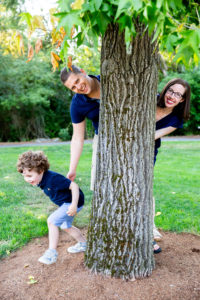Editor’s Note: Mamas Facing Forward has provided product links in this article as an Amazon Associate. If you choose to purchase after clicking the link, we may receive commission at no extra cost to you. Any funds we receive go towards providing more resources for moms and moms-to-be with chronic illness, so thanks for using our links!

For chronically ill parents, preschool and school-aged children pose different physical and emotional challenges than babies. “Big kids” require less help on a minute by minute basis, but their larger body masses and difficulties with self-regulation can challenge a parent’s body structures and energy levels. Anyone who’s tried to put a tantrumming three year old into a car seat can attest to this!
In this article I will provide tips for protecting one’s body and managing fatigue while parenting “big kids,” defined as aged three and older. I will draw from my training as an occupational therapist, which is a holistic field dedicated to helping people with physical and/or mental health challenges successfully complete everyday tasks. Occupational therapists have training in both the physical as well as the mental health aspects of chronic conditions, and are experts in “life hacks” and everyday workaround strategies. I will also draw from my experiences as a parent with rheumatoid arthritis and as a pediatric therapist.
The article is organized around the type of task, from toileting to eating to chores. At the end, I have two general sections on: managing your child’s challenging behaviors (regardless of the type of task) and general fatigue management strategies. I will mention some specific products I find helpful, but please note that I have no connection or relationship with any company or product mentioned! If you are looking for tips for the first two years of life (from newborn to toddlerhood), please see my other article.
Big Kid Toileting and General Hygiene Strategies:
Diapering a “big kid:” Most children in the United States are out of diapers at around 3 years old (see more information here). Since toddlers and 3 year olds are more difficult than babies to maneuver up and down from a formal “changing table,” considering the following when diapering and potty training your big kid:
Positioning:
- Up high or down low: If it is hard for you to lift your child up and down from a changing table, consider whether it would be easier to simply use a changing pad on the ground. For those with relatively more hand pain than leg pain (like myself), this can help you eliminate unnecessary stress on your arm and hand joints from lifting.
- Child’s position: Consider whether the diaper change can be done from a standing position. I found that this really helped for wet diapers, but it does hinge on the child being able to stand still!
Recommendations for while you are in the middle of the potty training process:
- A step stool can help your child get up and down from the toilet and will help you avoid having to lift them.
- Alternately, you can use a small toilet on the ground, which has the advantage of also allowing the child to have more ergonomic positioning.
Recommendations for after the child is fully potty trained:
- Wiping: It’s common for children to continue needing help with wiping, particularly after eliminating stool, until closer to 4-5 years old due to body awareness and motor coordination challenges. It might be easier for the parent to use a wet wipe rather than toilet paper, because the wet wipe requires less force due to less friction applied as you wipe.
- Hand hygiene: Since parents with chronic illnesses are often immunocompromised, it’s imperative to train your child to have good hand washing habits. Visual aids are often much more effective than verbal reminders. I recommend using a step by step poster like this one. Even better, take pictures of your child and put them into a poster to be placed in your bathroom, as most children like seeing pictures of themselves!
Showering and Bathing Recommendations:
- If you are using a bathtub, I recommend a knee pad for comfort while bending during bath time. This one is handy as it also has a storage area for shampoo and other bathing items, so you can keep everything necessary close at hand and avoid unnecessary reaching and lifting during the bathing process.
- Encourage your child to gain independence with bathing by making it as fun as possible for them. For example, in the bath you can give them a colorful sponge in the shape of their favorite animal and encourage the animal to “help” them scrub the dirt off their body.
- Always think about your own ergonomics when approaching awkward tasks like leaning over a bathtub. To avoid excessive bending and leaning, see if you can encourage your child to come to you rather than having you come to them. A common barrier is that some children don’t like having their hair washed or getting water on their faces. I found that once we started swim lessons, my son asked to wear his goggles in the bath, which helped a ton with him tolerating getting his hair washed!
Big Kid Feeding and Eating strategies
As a general principle, I tend to think about whether I’m going to alter which items I’m using (which I like to call, “Change the Stuff”), or whether I’m going to alter my approach regardless of what I’m using (which I like to call, “Change Your Approach”). This principle applies to feeding and eating items, as well as everything else I’m writing about!
Change the stuff: You can prevent pain by doing some of the following simple modifications:
- Pick out a high chair that your child can get into and out of independently, such as the Stokke Trip Trapp one. I particularly like this one because it has an adjustable seat as well as footrest level, and it can be used through adulthood (up to over 200 pounds).
- When your child still needs to be strapped into the high chair, select one with closures that are easier on your joints
- Use lightweight feeding utensils.
- Avoiding food packaging that is difficult to open. For example, I found that fruit pouches and individual sized applesauce containers were too difficult for me to open, but I was able to open a jar of applesauce and pour it into a bowl.
Change your approach:
- You might benefit from workaround strategies such as delegating feeding tasks to someone else. For example, you can order take out or having a friend/family/spouse help with meal prep.
- Another helpful approach is to teach your child to help out with meal prep and clean up. This article has some great tips for encouraging children to help out in the kitchen.
Moving around items: Car Seats, Strollers, and more
Car items:
- Type of seat: By 3 years old most children are in a convertible car seat, and after 4 many can fit into a booster seat although you may elect to keep them in a convertible seat longer for safety purposes. I recommend you focus on the closures (buckles), as well as on how easy the car seat is in install or remove if you plan on moving it between cars.
- Position of the car seat: You might have to do some trial and error, but I personally found it was much easier for me to get enough leverage to help get my son into and out of the car when he was placed in the middle seat versus the side seat.
- Who’s doing the buckling and unbuckling? The preschool aged child is usually able to buckle before they can unbuckle, and they eventually should be able to utilize one of the unbuckling tools such as Unbuckle Me or Bucklebee with adult supervision for safety.
- Vehicle choice: Your choice of vehicle will greatly influence how easily you can get your child into and out of your car. We purchased a minivan when my son was almost 3 years old. Minivans allow more ergonomic approaches and are easy for a child to independently get into and out of.
Strollers:
The same concepts from my post about baby strategies apply, which are namely:
- Size and weight of stroller: Would a more heavy duty stroller fit your needs better, or would a lighter but less stable stroller works better for your family?
- How easy is it to fold, transport and store? I liked using my BOB stroller for quite a while as I could keep it opened in the garage (thus minimizing the folding/carrying/lifting demands). Although it was heavy to open and close, it was very easy to push. At a certain point however, it became easier to just walk with him.
- Let them help: Can I teach/encourage my child to get into and out of the stroller independently to minimize my lifting demands?
Walking with your child:
Walking with one’s child in public areas can be a stressful experience for any parent, particularly those with chronic illness who are trying to keep their child safe while avoiding excess strain on their bodies. For example, I have to hold my son’s hand in the parking lot but he can “yank” me and hurt my fingers fairly easily.
- Can you change how you are holding onto your child? If your hands are hurting, I recommend having your child hold your forearm or hooking your elbow around your child’s elbow (which is a little awkward but can work). If they start yanking on you, you can stabilize them from the hips or trunk rather than pulling back on their hands. That will allow you to exert less force in order to keep them safe, and it will help keep your body safe as well.
Big Kid Dressing and Clothing Strategies
By 3 years old, many typically developing children are able to independently dress and undress themselves with the exception of jacket closures and shoes. This article by MamaOT gives a helpful breakdown of which dressing skills are typically achieved at which ages. I recommend encouraging your child’s independence as early as possible to minimize the strain on the parent!
- Zippers: If you struggle with helping your child with zippers you may benefit from a zipper pull, which is a device that makes it easier for you to pull a zipper up or down.
- Shoes: If you struggle with shoelaces, consider choosing alternate types of shoes that will be easier for your child to independently put on or take off.
- Buttons and closures: If your child needs help with those pesky buttons and other closures for jeans, consider opting for pants with elastic waists – my son happens to prefer these anyway, and it helps me avoid the pinching and pulling motions that will hurt my fingers.
Big Kid Sleeping Strategies
By 3, many preschoolers have outgrown their cribs. A parent with chronic illness may find it easier to transition their child to a “big kid bed” earlier rather than later because the big kid bed allows the child to independently get into and out of the bed without the parent having to lift them. We found it was simple and easy to have Charlie on a twin mattress on the ground for quite a while, however I should mention that I don’t struggle with bending. If bending or knee pain is an issue for you, a raised bed (with bedrails) would likely be a better choice than a mattress on the ground.
Big kid Chores
Don’t hesitate to encourage your child to help around the house – not only is it helpful to the chronically ill parent but it also helps the child build life skills including a sense of responsibility and self-efficacy. This article has great tips on which chores can be done by children at specific ages.
Managing Your Child’s Challenging Behaviors when You are Chronically Ill
Challenging behaviors are typical for preschool aged children as their brains are still developing self-control, delayed gratification, sustained attention, and social skills. Some strategies specific to families with a chronically ill parent include:
- Help your child understand your disability. There are some great books and blog posts that help children frame their parent’s disability. Particularly for invisible or hidden disabilities, you will need to be very concrete with your child about explaining how your disability affects you, as they will not have the abstract reasoning to understand things like fatigue very easily. Mariah has a great article with 5 tips for talking to your child about chronic illness, which includes specific book recommendations. I have simply said things to my son like, “Mama’s hands hurt so I can’t do X.” I have found that this has helped him develop empathy and it’s been sweet how he’s asked me “when my hands will get better,” although it’s hard to explain the chronic part to him at this age!
- Understand the pros and cons of using reward systems to help manage your child’s challenging behaviors: Many parents default to sticker charts and other reward/punishment systems. Research from psychology suggests they should be used with caution. I believe that reward systems are appropriate when the child is capable of the task but is specifically not doing it because they are not sufficiently motivated and they need a brief external bump in motivation. I find they are best used for tasks that don’t require that the child develop intrinsic motivation. For example, if your child is excessively wiggly or difficult to maneuver during changes, consider special rewards for desired behaviors in that context, such as special toys that are only available for their child during diaper changes.
Parental Fatigue Management
From my personal experience, the fatigue associated with parenting preschoolers and older children can feel different than that of parenting babies and toddlers; the minute by minute demands aren’t as relentless, but the psychological fatigue is a little more challenging. I have covered some task-specific tips for fatigue management above, but in general I recommend you consider:
- Activity pacing: Can you pace the activity so that you can last longer and don’t get tired too quickly? Sometimes this means going slower than you’d like, which is hard for me as I am pretty impatient, but I’ve had to learn to slow down in the beginning of a task (such as cooking) so I can last longer. Activity pacing includes altering easy with hard tasks or hard tasks with rest breaks as well.
- Clustering: Can you cluster errands together so you don’t have to unnecessarily repeat difficult actions such as getting your child into and out of the car seat? This requires a lot of planning ahead but I find it pays off long term.
- Workaround strategies: Can you find ways to avoid the task altogether? Grocery delivery, meal delivery, hiring help, and delegating tasks to others are all simple ways to help you avoid unnecessary energy expenditure.
Seeking expert guidance if needed/desired
Sometimes, you reach a plateau with your individual platter of life hacks and strategies. It’s often beneficial to seek expert guidance to help you sort through how to manage your life as a parent with a chronic illness. Consider the following professionals:
- Physical Strategies: Expert guidance for splinting and biomechanical approaches can be found by a referral to a certified hand therapist, occupational therapist, physical therapist, physiatrist, or other specialist. Ask your primary care doctor for a referral.
- Mental/stress management: I cannot over-exaggerate the degree to which having a psychologist for weekly therapy sessions has helped me cope with being a parent with multiple chronic illnesses. Some counselors even offer virtual visits, which can be so helpful for people with mobility or fatigue issues. Occupational therapists are also trained in mental health and can provide some support in this area as well.
- Parenting support: Most communities offer parenting classes, and parent coaches and online communities can help parents with chronic illnesses. I’ve personally found it helpful to remember that many other parents struggle with similar issues as I do, even if they are 100% able bodied!
Conclusion
Parenting is one of the toughest jobs in the world even for the healthy and able bodied. Chronic illnesses pose unique challenges to the parent of a “big kid,” but I hope that by sharing my personal and professional recommendations, the reader feels empowered with some strategies to make the process easier! Please let me know any of your additions in the comments section.





1 Comment
Fantastic article! Thank you!